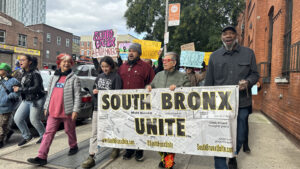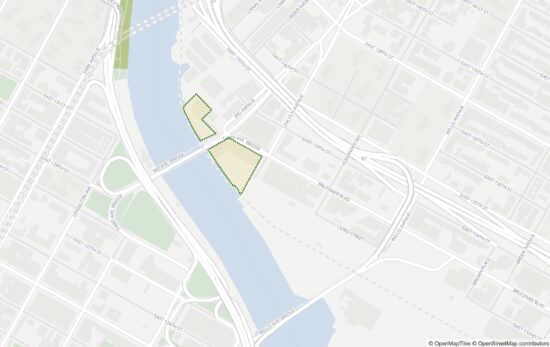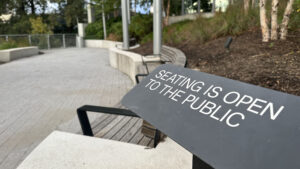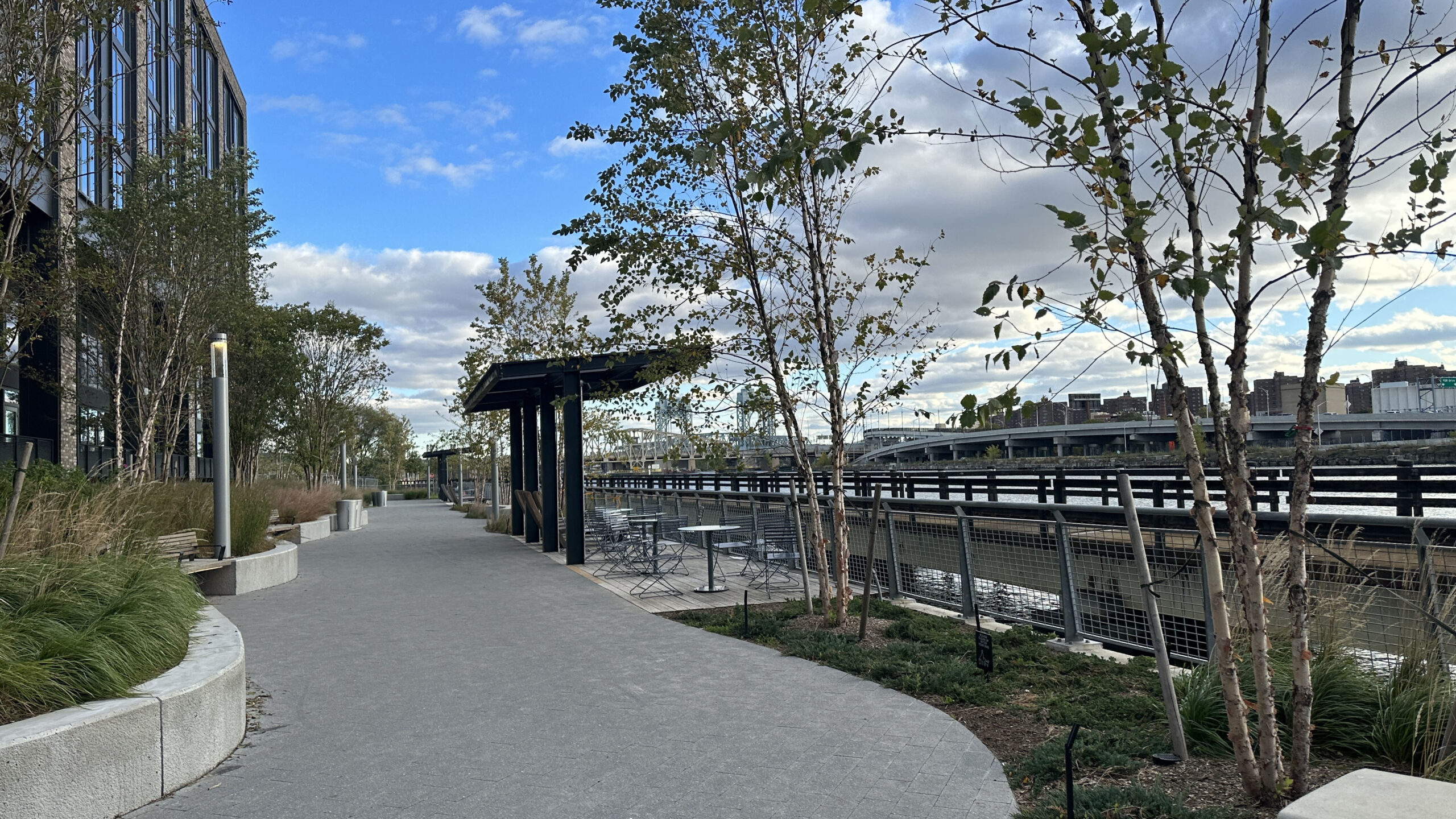Wooden benches and lounge chairs now line a section of the Harlem River, along with bistro tables and chairs, greenery and an accessible walking path. All of it is open to the public.
This promenade, just off Bruckner Boulevard and Third Avenue, is at the waterfront between the Third and Lincoln at Bankside apartment buildings. It offers a respite to read a book, walk a dog, talk with a friend or go for a run.
The Mott Haven-based grassroots group South Bronx Unite led nearly 50 people on a march to the area on Oct. 22 to introduce people to the spaces and emphasize that they are public, not private.
“There should be more people out here making noise because I’m sure there’s more people that don’t know we are allowed to be in this space,” said Brigette Brantley, a local activist and high school teacher, who said she learned about it from local news and social media. “You can’t come to my borough and tell me I’m not allowed to go anywhere,” she said, referencing a concern voiced by many longtime local residents that the new luxury buildings were luring outsiders to their neighborhoods and raising rents while blocking access to the waterfront.
Rents at Third at Bankside range between $2,605 for a studio to $6,070 for a 3-bedroom.
“Whose Bronx? Our Bronx,” marchers chanted. “Whose waterfront? Our waterfront!” As the rally approached the apartments, a pair of uniformed guards inside a security booth stared at the dozens of protesters. The duo didn’t say anything or try to stop the large group.
While the rally focused on issues beyond public access to the waterfront – from gentrification to “affordable housing” being unaffordable – the march was organized in response to an incident on Oct. 11. That Wednesday, Matthew Shore, South Bronx Unite’s green space equity and community land trust organizer, was giving a community tour to Columbia University students in an environmental justice class.
Shore said he took the students to the park behind the Lincoln at Bankside apartments, shown as Port Morris Waterfront Park on Google Maps. While there, a Bankside security guard told Shore he needed to “RSVP.” Shore said he told the guard it’s public space and that signs posted say so. When he asked the security guard who can access the space, Shore said the security guard replied, “It’s for residents.”

The Mott Haven Herald reached out to Brookfield Properties, the developer that built and operates both Third and Lincoln Bankside apartment buildings. Spokesperson Laura Montrose said in an email the guard had erred in saying that non-residents needed permission to enter and that Bankside is instructing its security, construction and management teams to ensure on-site staff are clear about the public’s access.

“All are welcome and no reservations are required,” Montrose said, noting that the Third at Bankside park is open from 6 a.m. until 1 a.m. – the same hours as most NYC public parks. Sections of Lincoln at Bankside’s park are still under construction but once completed, they will have the same operating hours, she said, adding that the company plans an opening ceremony in Spring 2024 “to celebrate with our neighbors and community.”
In 1993, New York City adopted special zoning regulations affecting waterfront development and areas designated Waterfront Public Access Areas, which are mapped out. Within these areas, developers must provide and maintain public spaces that access the waterfront, and post signs indicating the space is public and hours of operation.
“Our Waterfront Public Access Areas are vital to reconnect the public with their waterfront,” said Joe Marvilli, spokesperson for the Department of City Planning, in an email. “After decades of communities being cut off from their own shorelines, we’ve made major strides over the last 30 years to provide millions of New Yorkers with a place to exercise, relax, and interact with nature by the water.”
To access Third at Bankside’s waterfront promenade, one walks past a private parking roundabout in front of the building’s main entrance. Two signs along the walkway indicate “Seating is open to the public,” but no sign announces that at the front.
New York State Assemblymember Amanda Septimo (D-Bronx), marched alongside protesters while holding a sign that read, “Si se puede.”
“It really is a hidden gem. It’s beautiful. It’s tranquil,” said Septimo. “But you absolutely would not know it’s there if you didn’t know it was there, and even knowing it’s there you might be confused on how to reach it.”

Septimo said her office wrote a letter to Brookside Properties asking for their plan for “consistent, sustained, unfettered public access” to the waterfront parks to ensure the requirements are enforced.
Aimej Benitez lives in Third at Bankside apartments. The new mother often pushed her infant son in a stroller along the waterfront promenades. Benitez said she has always understood the waterfront parks are open to the public, especially because she sees kids hanging out after school.
“They come over, they sit down, they have their slices of pizza they get right over here at BX Slices or they go to the deli, and I see them all the time after school here,” Benitez said. She added the only time she’s seen a guard inquire is when there was a “huge field trip.” The 27-year-old said a guard once stopped her while she was at one of the waterfront parks at night. She initially took offense, but then realized it was out of concern because the space lacked lights.
After visiting Third at Bankside’s waterfront park, the group marched down Lincoln Avenue, across the railroad tracks, and stopped at an undeveloped waterfront access point along the Harlem River.
For the rally’s organizers, the minor mishap at Bankside in October with the Columbia environmental students was emblematic of a bigger conflict, highlighted in South Bronx Unite’s Mott Haven-Port Morris Waterfront Plan. That 12-page proposal calls for public access to the Harlem River, East River and Bronx Kill waterfronts to help combat high asthma rates and other pollution-related health problems, and to the increased risk of flooding due to climate change.
The Waterfront Plan also calls for the removal of several publicly-owned waterfront parcels from real estate speculation, and for neighborhood residents to steward these waterfront spaces, including a number of “development principles” advocates say are needed to ensure neighborhood residents aren’t left behind.
South Bronx Unite’s co-founder Mychal Johnson explained to the gathering that there’s a unique opportunity to restore this area into a green space. The activists urged the public to join the Local Action Committee, and called attention to the Community Land Act, which, if adopted, would require the city to prioritize nonprofits and community land trusts when it considers how public land should be used.
South Bronx Unite circulated a petition at the rally that now has about 100 signatures, urging local elected officials to support the initiatives.
“We’re not going to give up. We can’t do that. We can’t normalize it as it is,” said Johnson. “That’s why we’re doing all the things we can to show by ACTION that we can do something different. Not just with words.”
The story was updated on Nov. 15.

